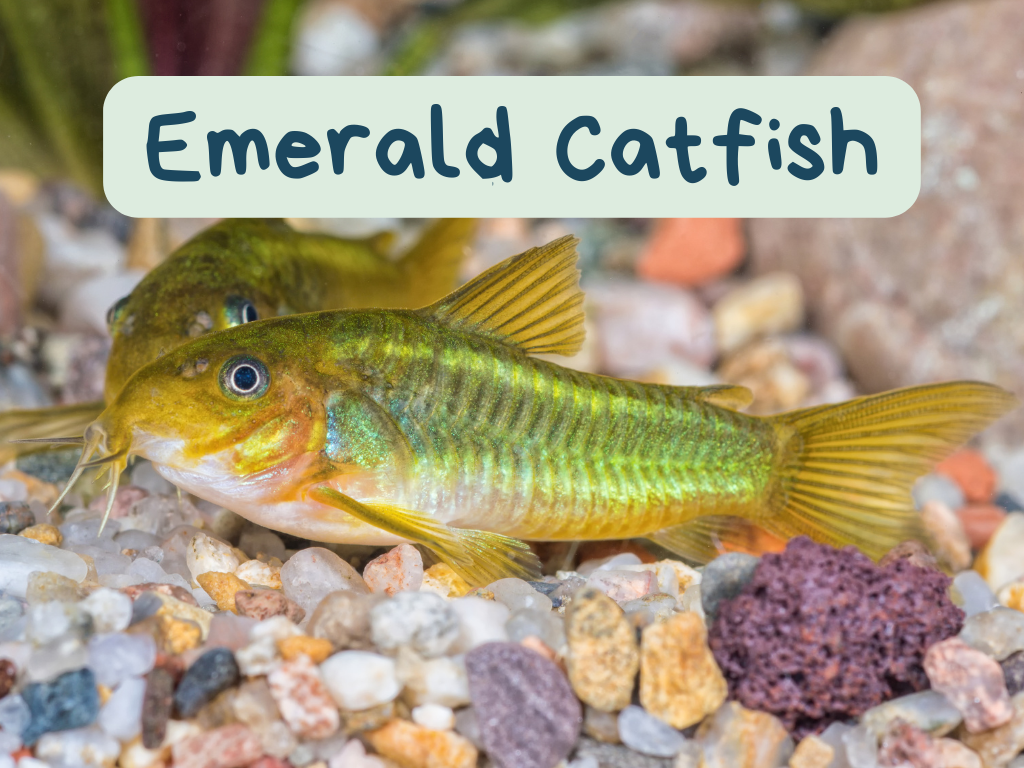Emerald Catfish
Description: The Emerald Catfish (Corydoras splendens) showcases a striking display with its metallic green to bluish-green body, depending on the lighting. It is one of the larger members of the Corydoras family, reaching lengths around 3 inches as adults, with females growing slightly larger. This species is distinguished by its vibrant hues and peaceful demeanor, making it a popular choice for freshwater aquarium enthusiasts.
Temperament: Emerald Catfish are known for their peaceful nature, making them excellent inhabitants for community aquariums. They thrive in schools of about 6, displaying more natural behaviors when kept in groups. Suitable tank mates include non-aggressive community fish, but they should not be housed with territorial or aggressive species that might harm them.

Identification
Emerald Catfish
Common Name: Emerald Catfish
Other Names: Green Cory Catfish, Emerald ‘Brochis’
Scientific Name: Corydoras splendens
Order: Siluriformes
Family: Callichthyidae
Genus: Corydoras
Species Facts
Emerald Catfish
Temperament: Peaceful and Sociable
Mature Size: 2.8 – 3.2 inches (7 – 8 cm)
Fish Origin: Brazil, Peru, Columbia, Bolivia, Ecuador
Diet: Omnivore
Reproduction: Egg Depositor
Max Lifespan: Around 5 Years
Tank Care
Emerald Catfish
Environment: Freshwater
pH: 5.0 – 8.0
Hardness: 36 – 268 ppm
Temperature: 68° – 82.4° F (20° – 28° C)
Minimum Tank Size: 55 gallons for 6 fish
Recommended # in school: at least 6-8
Care and Habitat
Emerald Catfish Diet: These catfish are omnivorous scavengers, favoring a varied diet that includes high-quality sinking pellets, live or frozen foods such as bloodworms, daphnia, and brine shrimp, as well as algae wafers. Feeding should occur daily, with portions they can consume within a few minutes to avoid overfeeding and ensure they receive adequate nutrition.
Emerald Catfish Care: Emerald Catfish require an aquarium with stable water conditions, including temperatures between 68° – 82.4° F (20° – 28° C) and a pH of 5.0-8.0. Their tank should have a soft substrate to prevent barbel erosion, and be well-equipped with hiding places like plants, rocks, and driftwood. Regular maintenance, including weekly water changes of 10-20% and monitoring of water parameters, is essential for their well-being.
Male vs Female: The sex of a Emerald Catfish is relatively easy to tell apart. The males have slender bodies and bright yellow bellies while the females are slightly larger and have pinkish coloring on their bellies.
Natural Habitat: Originating from the Amazon River basin in South America, Emerald Catfish inhabit slow-moving streams, tributaries, and flooded areas. These environments are characterized by warm, soft waters with dense vegetation, which should be mimicked in the aquarium setting for these catfish to thrive. For those looking to keep Emerald Catfish in their home aquariums, it’s crucial to replicate their natural habitat as closely as possible, provide a balanced diet, and maintain the aquarium with regular care and monitoring.

IUCN Red List Status: The Emerald Catfish is categorized as Least Concern (LC) by the International Union for Conservation of Nature (IUCN), which means that it does not currently qualify as Critically Endangered, Endangered, Vulnerable, or Near Threatened.
Aquaponic Considerations
| Can be used for Aquaponics | Yes |
| Common in Aquaponics | No |
| Indoor or Outdoor | Indoor Aquarium |
| Ornamental or Edible | Ornamental |
| Stocking Density | 55 gallons for 6 fish |
To learn more about Aquaponics, explore our Aquaponics Information and Hobby Center.
Sources
The primary resources used for this article include the IUCN Red List of Threatened Species, FishBase, and other aquarium databases.


